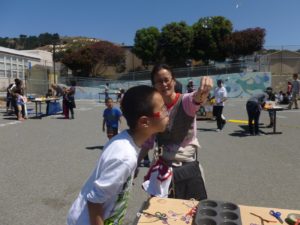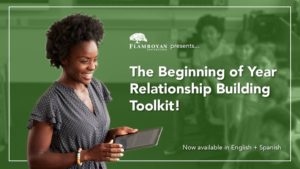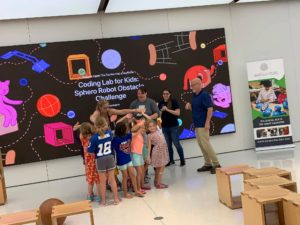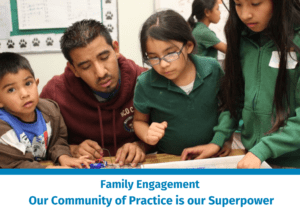The afterschool community has stepped up with its superpower in responding to the education, social, economic, and health challenges of the past year and half for different communities. What they’ve had in common is creating deeper partnerships with families.

Photo Credit: Bay Area STEM Ecosystem
STEM Next has taken notice of how out-of-school-time leaders expanded their mission to meet the immediate needs of families in their communities while reimagining how to deliver STEM programming. Programs supplied STEM resources with meals, diapers, and homework packets. Staff went into homes to help grandparents set up laptops and Internet connections for their grandchildren. Afterschool programs delivered STEM activities and materials –with some resourceful new partners like football players and food service workers— so that youth could access them at home. Sometimes parents, grandparents, and siblings were at the table, on the porch, or in the backyard for these lessons. Afterschool teams got creative and reworked STEM activities, so they were self-directed for when families had time. Sometimes projects like Technovation’s Family AI program, were facilitated in real time over Zoom with families across town, country, or continent. We witnessed lots of creative ways of bringing STEM to youth and engaging with families. Families were appreciative and their kids were engaged and inspired with STEM.
We learned a lot from having to adapt and find new ways to deliver programs and engage with families. Let’s take this opportunity to bring back the best of our successful in-person activities from the past and build on innovative and inclusive ideas. Here are four ideas to lift family engagement and make this an amazing year in afterschool.

Photo credit: Flamboyan Foundation
1. Make it about connections. Prioritize getting to know families and building relationships from the start.
Follow the example of Dr. Susan Enfield, superintendent of Highline Public Schools in Burien, WA. Enfield leads with The Highline Promise, to know every student by name, strength, and need. Every student in Highline has an adult assigned to them. These adults build relationships and check in with questions like “How are you? What do you need? What was a success for you this week? What was the challenge?” Imagine if adults during the school day and after school partnered to make these connections happen in every school.
Make a promise to get to know every family of every child in your afterschool programs. We heard about how staff of afterschool programs checked in on families last year with phone calls, Zoom, Facetime, text messages, and chats on the porch. For many it was their first time making these contacts a regular part of their work. Here are four strategies to make these connections impactful. Lead with a check-in on the parent or caregiver. Encourage parents to share with prompts like “How are you? How can I help?” Share a positive story about their child. Parents and caregivers appreciate hearing about how their child helped a peer or found a creative solution to a challenge in afterschool. Invite parents and guardians to share their interests and questions. Brainstorm with your team on how these can be incorporated into family engagement. Assign a consistent staff member to check-in to build trust and understanding with parents and caregivers. You can find more ideas for check-ins with families in the Beginning of Year Relationship Building Toolkit from the Flamboyan Foundation.
For in-person activities, make getting to know families just as important as leading STEM activities. Check out the About Me, About Us exercise in the Family Creative Learning Facilitator Guide. In this activity families share their names, a drawing of themselves, something they like to do, and something they like about themselves. What we especially appreciate about this lesson is that it elevates relationships across staff and families and helps ease participants into STEM with familiar materials and activities. Learning to pronounce names correctly can be incorporated into this lesson. For more on this topic, check out Honor Your Students’ Heritage by Pronouncing Their Names Correctly, a PBS SoCal blog by Françoise Thenoux.
2. Hold onto strategies that allow more families to participate. While we missed seeing families in person last school year, the virtual events that afterschool programs hosted to keep families and staff safe had some positive outcomes.
Several afterschool programs were able to reach more families with STEM activities on Zoom and Facebook Live. Some found that they connected with new groups of families who had been missed in past outreach attempts. Without the challenge of childcare, conflicts with work schedule, transportation, or discomfort going to an unfamiliar place with strangers, some parents were able to participate for the first time in STEM activities from the comfort of their home. Some afterschool programs discovered that family events held outside in neighborhood parks or by community centers were better attended than those at school.
Techbridge Girls adapted its STEM curriculum and made Techbridge Girls@Home available free and online for any girl and family. Understanding that childcare could be a barrier for some, girls were invited to engage in STEM activities with siblings. Scientific Adventures for Girls hosted virtual family STEM events with STEM role models across the San Francisco Bay Area. These virtual family events expanded opportunities for career exploration by allowing more role models and families to participate.
We love the creativity of these afterschool programs in bringing STEM opportunities to families. As you plan family engagement this year, consider how you might offer a blend of in-person and virtual options. Reimagine when, where, and how afterschool programs can create family engagement with greater impact and with greater access.

Photo credit: Deaf Kids Code
3. “Thanks for the Feedback.” This is the title of a terrific book by Douglas Stone and Sheila Heen; one that we recommend for creating a work environment where feedback and innovation are encouraged. The statement can also be a guiding principle for this year’s family engagement.
What better way to prepare for this year’s afterschool programs than by listening to parents. Parents and guardians have closely engaged in their child’s learning during the pandemic and have insights that can help inform afterschool staff. Check out this planning tool from Learning Heroes to help staff and volunteers get to know family members of children in their programs. We suggest that you adapt the tool and ask parents a select few prompts like “My child is excited to learn about…. Changes I’ve noticed in my child that are important for you to know…” Rather than ask parents to download, complete, and pass along to a classroom teacher, create a format that will be accessible across all families in afterschool programs and classrooms.
Ask for feedback on elements of your afterschool programs that may help increase diversity and inclusion. For instance, ask parents of children with disabilities what might be barriers to participation and ideas for helping their family participate in afterschool programs. Find more ideas in our case study, Set a Place at the STEM Table for Youth with Disabilities and their Families. Start early so that there are no surprises or missed opportunities to make timely course corrections. Let parents know why you are asking for their ideas. Don’t forget to close the loop; show and tell families what you learned from their feedback and how you plan to use it. If there are ideas that you can’t put into practice, let families know and provide an explanation.
We love the ideas in What We Can Learn from Families in this Joan Ganz Cooney Center blog by Brigid Barron, Susie Garcia, Caitlin K. Martin, and Rose K. Pozos. “As we prepare for a future that includes new forms of remote and hybrid learning, it is essential to recognize the implicit collaboration between teachers and caregivers in supporting learning and the need for new ways to better support that teamwork moving forward. We need to ensure that these types of relational supports are happening for all families.” We couldn’t agree more. Enlist families and staff in the feedback loop to make family engagement succeed for every family.

Photo Credit: Techbridge Girls
4. Invest in family engagement, invest in professional development. Family engagement is an important lever for closing the opportunity gap in STEM. STEM Next is committed to impactful and equitable family engagement with deep investment in research, resources, and professional development.
Just as impactful family engagement requires deep touch points, so too does professional development. STEM Next is building a community of practice (CoP) model to support family engagement in STEM for professionals in out-of-school-time. This capacity-building model provides for reflecting, sharing strategies and resources, and creating an action plan with partners for greater collective impact. We are launching our second cohort with the 50 State Afterschool Network as part of STEM Next’s national gender equity initiative, the Million Girls Moonshot. Results are positive and learning goes around — among participants and our STEM Next team. We couldn’t be more pleased that one of the teams from our previous CoP is hosting a CoP of its own. The West Virginia Statewide Afterschool Network is leading this work to deepen its family engagement for 10 afterschool programs in partnership with the WV Department of Education, the WV Department of Health and Human Resources, and the EdVenture Group. We see our garden growing; the seeds planted in our CoP this spring are taking hold and with cultivation these professional development efforts are growing into deeper family engagement in STEM in afterschool.
There is a great and growing community of champions of family engagement. We encourage you to learn from their successes, challenges, and lessons learned. Here are a few resources on family engagement in STEM to help you plan for greater diversity and inclusion. Embracing a New Normal: Toward a More Liberatory Approach to Family Engagement by Drs. Karen Mapp and Eyal Bergman. STEM Family Engagement: A Planning Tool is in development by the Institute for the Study of Resilience in Youth at McLean Hospital (coming soon). For more ideas, check out The Family Engagement Project on the STEM Next website.
This is going to be a year like no other with a big opportunity to engage with families in new ways. Place relationships with families at the center of programs in school, afterschool, and at home, and we can have greater collective impact in closing the opportunity gap in STEM. Will you join STEM Next and make a pledge to take up one of the ideas in this blog? Share your pledge on social media #MyFamilyEngagementPledge.
Linda Kekelis is an advisor on the Family Engagement Project at STEM Next Opportunity Fund. She has spent her lifetime involved in family engagement. As a parent and grandparent, Linda enjoys learning new ways to support STEM wonder in children and increasing her own confidence in STEM. Linda appreciates the examples of resourceful family engagement she discovers in her work with afterschool program across the country and around the world. lkekelis@gmail.com @LindaKekelis
Ron Ottinger is Executive Director of STEM Next Opportunity Fund and former co-chair of the national STEM Funders Network and the National STEM Learning Ecosystem Initiative. rlottinger@stemnext.org @STEMNext

